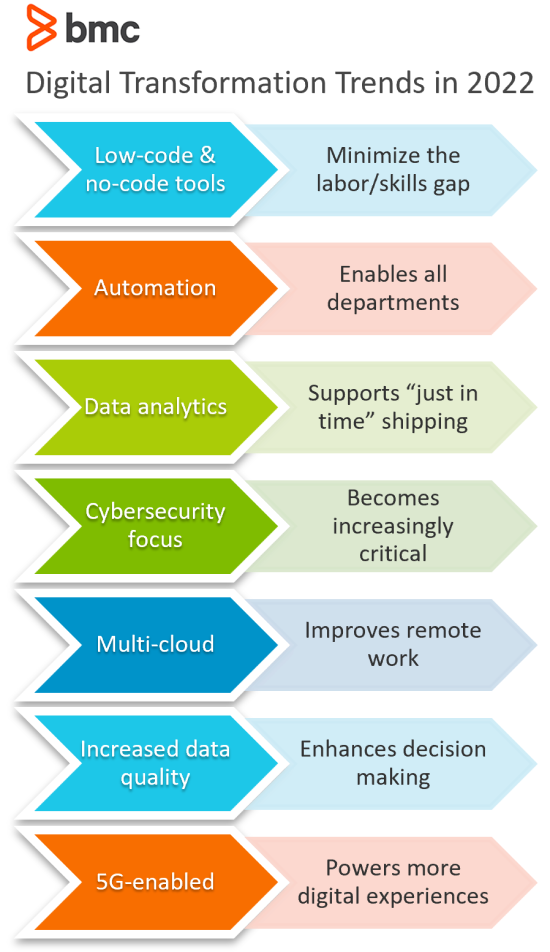The past two years have seen radical digital transformation. Companies and industries that have traditionally been hesitant to adopt new technology suddenly embraced their digital transformations—they needed to find new ways to work.
Interestingly, many experts believe that these radical shifts are only the beginning.
In a recent Deloitte survey, three-quarters of executives stated that they expect more changes in the next five years than there were in the past five years. The rate of change only increases as organizations are more open and willing to make the changes they need to keep up with the competition.
Digital transformation (DX) encourages business organizations to adopt new technologies in order to deliver better value to their customers. DX transcends traditional customer engagement channels, such as marketing and advertisements, and encompasses the processes, culture, technologies, and experiences that collectively determine the business value of reaching the right customers at the right time.
At the same time, embracing digital transformation saves business organizations valuable resources and generates new revenue streams. DX-focused technology solutions and service models operate productively and scale their services with agility.
In this article, let’s explore what’s trending in digital transformation for 2022.

Low-code tools will help meet the labor shortage
The DevOps skill shortage is a problem for most businesses: The U.S. Bureau of Labor Statistics indicates that there will be a 1.2 million shortage in engineers by 2026. Low-code and no-code software are critical tools to help businesses fill this gap in 2022.
For many years, low code tools have been a source of controversy in the IT community. Many developers worried that low code software could replace their jobs and that organizations could run on their own with these tools. However, this controversy is now fading as low-code software becomes an asset for developers.
The low-code tools of 2022 enable developers to solve more straightforward problems that take up too much of their time. Instead, IT can concentrate on higher-quality tasks and become more effective. Organizations that combine this low-code software with professional developers increase their total digital impact and gain an edge over the competition.
In addition to the total impact on organizations, low-code tools are leading to the democratization of AI. There is no longer a steep learning curve for software, allowing professionals in other departments to make smart decisions. It makes it accessible to every organization and every person within the organization.
As data quality and use cases expand, businesses rely more on it for daily operation. Low-code software provides a valuable bridge between the broader business requirements and what developers need to concentrate on to take companies to the next level.
Robotics will improve every department
Companies are increasingly turning to robotic process automation (RPA) to streamline their processes and save on costs. As a result, RPA adoption is exploded. In fact, experts, the market will surge 53% in 2022—growing from $2 billion in 2021 to $3.17 billion this year.
RPA continues to grow as the use cases for robotic automation continue to expand as well. It offers organizations many benefits:
- Enhanced efficiency
- Increased security and compliance
- Improved analytics
- Streamlined scalability
- Enhanced customer experience
Automation is no longer limited to large enterprises. Small- and medium-sized businesses (SMBs) in all industries need to implement RPA in their companies to stay ahead of the curve in all areas, including customer support, marketing, and accounting.
This year will see more companies harnessing automation and RPA to perfect their business operations while lowering costs.
Data analytics will enable “just in time” shipping
2021 was a year of significant supply chain disruption. While supply chain issues were expected during the first part of the pandemic in 2020, the continued inventory shortages and shipping delays over a year later left many organizations reeling. Companies of all sizes were scrambling to get what they needed and continue to meet demand.
With a supply chain crisis on their hands, many companies will turn to data analytics in 2022 to help them meet their challenges. They will be forced to address bottlenecks and fragilities in their data pipelines that cause a lack of visibility into their supply chains. Legacy models, systems, and approaches will no longer hold back organizations as they turn to new solutions to meet their needs.
“Just-in-time” shipping is possible for organizations in 2022 with the right data analytics to provide insights.
Improvements in cybersecurity
For the past two years, businesses have experienced escalating threats to their data. 2021 saw the biggest cyberattack to date and became a wake-up call for many organizations to prioritize cybersecurity. In 2022, data protection and cybersecurity will be at the forefront of digital transformation.
However, the rise in remote work has made companies more vulnerable than ever. Last year saw the average cost of a data breach increase, averaging about $4.24 million per company. Although leaders expected that workers would return to offices at some, it is becoming increasingly clear with changing employee attitudes and the emergence of COVID-19 variants that a complete return to office will not be possible for everyone.
The good news is that there are better options for companies to improve their data security. Just a few of the new technologies in cybersecurity include:
- Enhanced encryption methods
- AI-enabled threat detection systems
- Embedded hardware authentication
- Blockchain security
- Zero-trust model
There are many steps that organizations can take to keep their data safe. Expect to see even more as companies are starting to realize how critical it is.
Multi-cloud architecture to improve remote work and security
2021 saw many organizations move away from on-premises software and embrace cloud-based solutions. Experts estimate that by the end of 2022, cloud spend will exceed $480 billion.
This ubiquity in the cloud leads to an increase in multi-cloud architecture for many organizations. As companies use more than one private and public clouds, they are changing the way they distribute the software and workloads within it.
Multi-cloud architecture is particularly critical in the wake of remote work and emphasis on security. For many organizations, the increase in cybersecurity outweighs the potential complexity in their infrastructure management. They can manage the risk of employees accessing their network from home and improve disaster residency requirements, resilience, and disaster recovery.
A multi-cloud strategy has already been largely adopted across enterprises: 92% surveyed last year said they have a multi-cloud strategy. However, 2022 will see this trend trickle down as SMBs continue to follow.
(Get more cloud & SaaS statistics.)
Improved data quality for better analytics and decisions
Data-driven decisions are a fundamental part of digital transformation. They provide organizations with critical insights that shape how leaders improve and streamline their businesses. Using data to drive decision-making is a key reason many companies undergo a digital transformation.
However, these decisions are only as good as the quality of data. Bad quality data hurts many organizations and the decisions that they make. Experts estimate that the average cost of poor data quality for an organization is $12.9 million.
This number will only rise with an increase in dependence on digital channels for selling services and products. From predictive analytics to accurate insights into leads, poor quality data means that organizations miss out on key opportunities.
Not only does it directly impact the short-term revenue, but the downstream effects of poor data lead to complex data ecosystems and poor decision making.
Good quality data offers a better understanding of the customer, which means better leads, algorithms, and customer relationships. That is why many organizations are tackling data quality in 2022. Improving data quality standards, implementing data cleaning tactics, and tracking data quality levels through metrics will grow increasingly popular as companies realize how critical they are to business success.
(Compare data quality to data integrity.)
5G-enabled will soon be a necessity
The start of this year saw a slowdown in 5G as the Federal Aviation Administration and 5G carriers struggled to agree on the safety of 5G service on aircraft. However, they have recently come to an agreement, allowing 5G to grow more than ever.
What does this mean for businesses? The fast-paced transition to a 5G-driven era means that employees and consumers will expect improved digital experiences that will require investments in 5G technologies. Most tech companies will likely continue to encourage their workforce to work from home. 5G internet speed will be instrumental in improving all digital experiences currently limited by slow internet.
Similarly, consumers will expect more responsive, data-driven services, especially as AR/AI becomes a reality in the 5G era.







